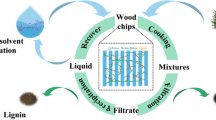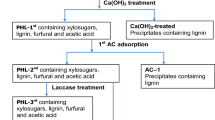Abstract
Pre-pulping extraction is a means of deriving a hemicellulose-rich process stream from the front end of a kraft pulp mill. When the extraction is carried out using green liquor, pulp quality and quantity can be retained while still releasing hemicelluloses and acetic acid (HAc) for recovery as bioprocessing feedstock or chemical products. The HAc that is present in the wood extraction is inhibitory to microorganisms and can hinder fermentation. HAc is also a commodity chemical that may provide sufficient value to justify recovery and purification. In this study, a liquid–liquid extraction (LLE) method is applied to extract HAc from a green liquor pre-pulping hardwood extract (GLE). The HAc removal is carried out after acid hydrolysis and prior to fermentation. Two organic solutions: trioctylphosphine oxide (TOPO) diluted in undecane and trioctylamine (TOA) diluted in octanol were tested for their abilities to extract HAc from GLE and to be recycled back through the process. GLE was contacted with the organic solvents, phase separated by centrifugation, and the organic phase was then distilled to recover the acetic acid. The solvent was then recycled back for a subsequent extraction of fresh GLE. It was found that TOA was a superior extractant, but failed to easily release its HAc through distillation. It also quickly became contaminated with other compounds in the wood extracts and lost its extraction efficiency after only a few recycles. The TOPO solvent did release its HAc through distillation but also lost extraction capacity with recycling. Back extraction of the TOPO solvent with sodium hydroxide solution restored the performance of the TOPO solvent.











Similar content being viewed by others
References
Ahsan, L., Jahan, M. S., Liu, H., & Ni, Y. (2012). Recovery of acetic acid from pre-hydrolysis liquor of the Kraft based dissolving pulp production process by reactive extraction with tri-octyl amine (TOA) and octanol. Journal of Forestry, 2, 38–43.
Ahsan, L., Jahan, M. S., & Ni, Y. (2013). Recovery of acetic acid from the prehydrolysis liquor of Kraft based dissolving pulp production process: Sodium hydroxide back extraction from the trioctylamine/octanol system. Industrial & Engineering Chemistry Research, 52(26), 9270–9275.
Al-Mudhaf, H., Hegazi, M., & Abu-Shady, A. (2002). Partition data of acetic acid between aqueous NaCl solutions and trioctylphosphine oxide in cyclohexane diluent. Separation and Purification Technology, 27(1), 41–50.
Cebreiros, F., Guigou, M. D., & Cabrera, M. N. (2017). Integrated forest biorefineries: recovery of acetic acid as a by-product from eucalyptus wood hemicellulosic hydrolysates by solvent extraction. Industrial Crops and Products, 109, 101–108.
Golob, J., Grilc, V., & Zadnik, B. (1981). Extraction of acetic acid from dilute aqueous solutions with trioctylphosphine oxide. Industrial and Engineering Chemistry Process Design and Development, 20(3), 433–435.
Van Heiningen, A. (2006). Converting a kraft pulp mill into an integrated forest biorefinery. PAPTAC, 107, 141–146.
Holtzapple, M. T., Davison, R. R., Ross, M. K., Aldrett-Lee, S., Nagwani, M., Lee, C. M., Lee, C., Adelson, S., Kaar, W., Gaskin, D., Shirage, H., Chang, N., Chang, V. S., & Loescher, M. E. (1999). Biomass conversion to mixed alcohol fuels using the MixAlco process. Applied Biochemistry and Biotechnology, 79(1–3), 609–631.
Kim, S. J., & Um, B. H. (2015). Comparison of hemicellulose extracts from two pulping woodchips with green liquor followed by scale-up pre-hemicellulose extraction. Applied Biochemistry and Biotechnology, 175(5), 2501–2515.
Kim, S. J., & Um, B. H. (2018). Delignification from Geodae-Uksae1 using soda-pulping followed by evaluation on recycling of liquid–liquid extraction solvent. Biomass and Bioenergy, 109, 23–30.
Kim, S. J., Kwon, H. S., Kim, G. H., & Um, B. H. (2015). Green liquor extraction of hemicellulosic fractions and subsequent organic acid recovery from the extracts using liquid–liquid extraction. Industrial Crops and Products, 67, 395–402.
Kolb, B., & Ettre, L. S. (2006). Static headspace-gas chromatography: theory and practice, 2nd ed. (pp. 1–4). New Jersey: John Wiley & Sons.
Matsumoto, M., Uenoyama, S., Hano, T., Hirata, M., & Miura, S. (1996). Extraction kinetics of organic acids with tri-n-octylphosphine oxide. Journal of Chemical Technology and Biotechnology, 67(3), 260–264.
Niitsu, M., & Sekine, T. (1978). Solvent extraction equilibria of acids. VI. The extraction of several mono- and dicarboxylic acids with trioctylphosphine oxide in hexane. Bulletin of the Chemical Society of Japan, 51(3), 705–709.
Roos, M., & Bart, H.-J. (2001). Extraction of acetic acid with tri-n-octylamine: physical properties and phase equilibria. Journal of Chemical & Engineering Data, 46(5), 1198–1202.
Siostrom, E. (2013). Wood Chemistry: Fundamentals and Applications, 2nd ed., (pp. 65). California: Academic Press.
Takahashi, C. M., Takahashi, D. F., Carvalhal, M. L., & Alterthum, F. (1999). Effects of acetate on the growth and fermentation performance of Escherichia coli KO11. Applied Biochemistry and Biotechnology, 81(3), 193–203.
Um, B., Friedman, B., & van Walsum, G. P. (2011). Conditioning hardwood-derived pre-pulping extracts for use in fermentation through removal and recovery of acetic acid using trioctylphosphine oxide (TOPO). Holzforschung, 65(1), 1–127.
Van Heiningen, A., Sixta, H., Um, B.-H., & Van Walsum, P. (2014). Recovery of acetic acid from wood extracts. Google Patents.
Walton, S. L., Hutto, D., Genco, J. M., Walsum, G. P. v., & Heiningen, A. R. v. (2010). Pre-extraction of hemicelluloses from hardwood chips using an alkaline wood pulping solution followed by Kraft pulping of the extracted wood chips. Industrial & Engineering Chemistry Research, 49(24), 12638–12645.
Yang, S. T., White, S. A., & Hsu, S. T. (1991). Extraction of carboxylic acids with tertiary and quaternary amines: effect of pH. Industrial & Engineering Chemistry Research, 30(6), 1335–1342.
Yang, G., Jahan, M. S., Ahsan, L., & Ni, Y. (2013). Influence of the diluent on the extraction of acetic acid from the prehydrolysis liquor of Kraft based dissolving pulp production process by tertiary amine. Separation and Purification Technology, 120, 341–345.
Yang, G., Jahan, M. S., Ahsan, L., Zheng, L., & Ni, Y. (2013). Recovery of acetic acid from pre-hydrolysis liquor of hardwood Kraft-based dissolving pulp production process by reactive extraction with triisooctylamine. Bioresource Technology, 138, 253–258.
Zeikus, J. (1980). Chemical and fuel production by anaerobic bacteria. Annual Reviews in Microbiology, 34(1), 423–464.
Zhang, L., Chung, J., Jiang, Q., Sun, R., Zhang, J., Zhong, Y., & Ren, N. (2017). Characteristics of rumen microorganisms involved in anaerobic degradation of cellulose at various pH values. RSC Advances, 7(64), 40303–40310.
Acknowledgments
We thank Dr. Martin Lawoko and Dr. Sara Walton for the analytical support they provided. USDoE award number: DE-FG36-08GO18165.
Author information
Authors and Affiliations
Corresponding author
Ethics declarations
Conflict of Interest
The authors declare that they have no conflict of interest.
Rights and permissions
About this article
Cite this article
Abdulrahman, A., van Walsum, G.P. & Um, BH. Acetic Acid Removal from Pre-Pulping Wood Extract with Recovery and Recycling of Extraction Solvents. Appl Biochem Biotechnol 187, 378–395 (2019). https://doi.org/10.1007/s12010-018-2826-z
Received:
Accepted:
Published:
Issue Date:
DOI: https://doi.org/10.1007/s12010-018-2826-z




